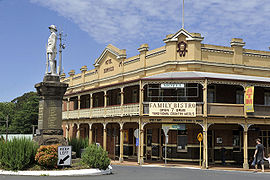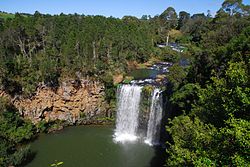- Dorrigo, New South Wales
-
Dorrigo
New South Wales
Dorrigo Main SquarePopulation: 967 (2006 census)[1] Postcode: 2453 Elevation: 762 m (2,500 ft) Location: 580 km (360 mi) N of Sydney Dorrigo is a small town located on the Waterfall Way in northern New South Wales, Australia. It is approximately 580 kilometres north of the state capital, Sydney via the Pacific Highway, and 60 kilometres from the coastal city of Coffs Harbour. The town is situated on the Dorrigo Plateau near the New England Escarpment,[2] which is part of the Great Dividing Range. Dorrigo is 762 metres above sea level.[2] At the 2006 census, Dorrigo had a population of 967 people.[1]
Contents
History
Before European settlement the area that is now Dorrigo was inhabited by the Gumbaynggirr. European settlement of the area followed on from the early timber cutters in the 1860s. The first official European in the district was Land Commissioner Oakes who sighted the mouth of the Bellinger River.
Dorrigo is derived from the Aboriginal word, dondorrigo, meaning "stringy-bark".[3] For many decades it was believed that explorer and settler Major Edward Parke named the region after a Spanish General named Don Dorrigo with whom Peake fought in the Peninsula War.[2]
By 1841, timber cutters had entered the Bellinger River searching for red cedar (Toona australis). They set up camps and moved from one stand of trees to the next.[2]
Richard Craig (an escaped convict from the Moreton Bay Penal Settlement),[2][4] was the first European to discover the Plateau, following the traditional indigenous route to Armidale, New South Wales from the Grafton area. Using his skills as a horseman, Craig travelled along the western side of the Nymboida River. Craig's track became a road, now roughly following the same path as the present Grafton to Armidale Rd and travelling through the present day villages of Nymboida, Billy's Creek, Dundurrabin, Tyringham and Ebor (elevation 1300m).[4] Timbergetters followed Craig through the sub tropical rainforest and many sawmills grew due to demand for timber, intitially the highly prized Australian Red Cedar (Toona australis).
Today, the main access road traversing the plateau from east to west is the Waterfall Way. It was not until the 1860s that permanent settlement occurred in the district. The dairy industry became a mainstay of the Dorrigo Plateau and today tourism is becoming more important. The nearby World Heritage listed Dorrigo National Park and New England National Park cater for persons interested in natural sights.
On 31 October 2005, sixty-eight dairy cows, all in full milk, died on a farm at Fernbrook on the Waterfall Way near Dorrigo after being struck by lightning. Three others were paralysed for several hours but they later made a full recovery. The cows were sheltering under a tree when it was struck by lightning and the electricity spread onto the surrounding soil killing the animals.
Dorrigo is home to the Dorrigo Steam Railway and Museum which houses the largest collection of preserved railway vehicles and memorabilia from the various Government and private railways of New South Wales. It is one of the most comprehensive railway collections in the world, with items in the collection ranging from 1855 to the present day. The museum is not yet open to the public however the larger items such as steam engines and carriages can be viewed from outside the property.
Dangar Falls
Dangar Falls are located about 1.2 km north of Dorrigo, on the Bielsdown River.[5] The falls are small but picturesque, and are a popular photographic subject.[6] For a short time after rain they are quite spectacular.[7] There is an attractive picnic spot which offers excellent views. It is possible to climb down the banks and walk along the river below the water falls.
Note:
- These falls are often confused with Dangars Falls, near Armidale, about 125 km to the west, along the Waterfall Way.
- For more information about Dangars Falls see the articles on Dangarsleigh and on the Oxley Wild Rivers National Park.
Coordinates: 30°20′24″S 152°42′43″E / 30.34°S 152.71194°E
Media
A local newspaper, the Don Dorrigo Gazette, was first published in 1910. It is believed to be the last newspaper in Australia printed using hot metal typesetting.[8]
References
- ^ a b Australian Bureau of Statistics (25 October 2007). "Dorrigo (L) (Urban Centre/Locality)". 2006 Census QuickStats. http://www.censusdata.abs.gov.au/ABSNavigation/prenav/LocationSearch?collection=Census&period=2006&areacode=UCL127400&producttype=QuickStats&breadcrumb=PL&action=401. Retrieved 20 July 2009.
- ^ a b c d e "Dorrigo". The Sydney Morning Herald. 2004-02-08. http://www.smh.com.au/news/New-South-Wales/Dorrigo/2005/02/17/1108500196325.html. Retrieved 2008-01-24.
- ^ "Dorrigo". Geographical Names Board of New South Wales. http://www.gnb.nsw.gov.au/name_search/extract?id=SXQlZxWATR. Retrieved 20 July 2009.
- ^ a b "History of the Dorrigo Area". Dorrigo Chamber of Commerce. 2009. http://www.dorrigo.com/community/about-the-dorrigo-plateau/135-history-of-the-dorrigo-area.html. Retrieved 1 August 2011.
- ^ "Dangar Falls". Geographical Names Board, New South Wales Government. http://www.gnb.nsw.gov.au/name_search/extract?id=JPYbjzxOIt. Retrieved 2009-06-29.
- ^ "Dangar Falls". Stevografix. http://www.stevografix.com.au/dangar_falls1.html. Retrieved 2009-06-30.
- ^ "Dangar Falls 31.3.09". ABC Contribute. http://contribute.abc.net.au/_Dangar-falls-31309/photo/3051646/32422.html. Retrieved 2009-06-30.
- ^ Huxley, John (2010-03-01). "News fit to print - hot-metal typesetting paper turns 100". Sydney Morning Herald. http://www.smh.com.au/nsw/news-fit-to-print--hotmetal-typesetting-paper-turns-100-20100228-pb6m.html.
Categories:- Towns in New South Wales
- Australian soldier settlements
- Australian Aboriginal placenames
Wikimedia Foundation. 2010.




